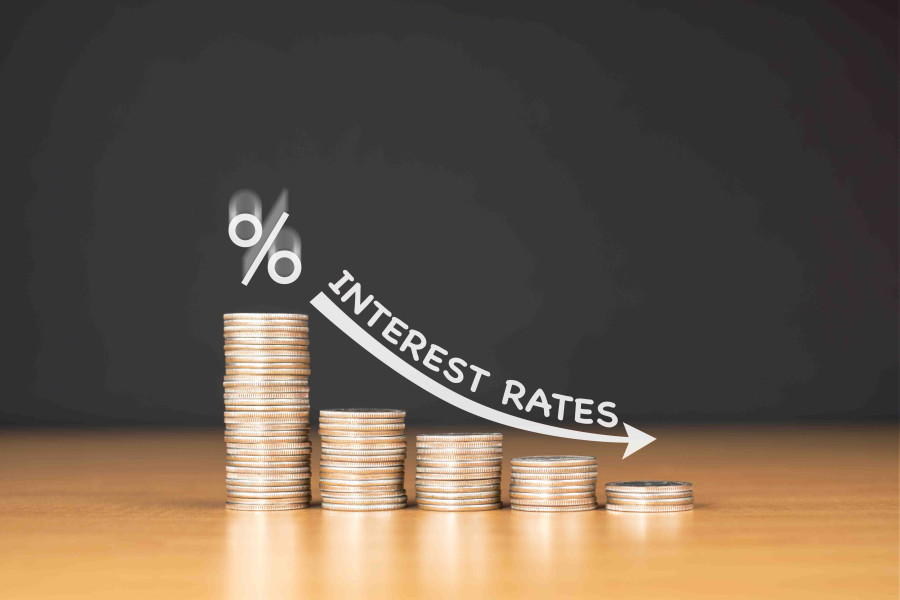Money
Interest rate on fixed deposits slashed to 11 percent
Deposits have been increasing, and banks are in a comfortable position in terms of liquidity, insiders say.
Krishana Prasain
Nepali banks will be paying 1 percentage point less interest on fixed deposits from January 15. "Depositors will get 11 percent interest on their money," said Sunil KC, CEO of NMB Bank and president of the Nepal Bankers Association.
As per the decision made by the association on Thursday, the institutional interest rate will also be slashed from 10.13 to 9 percent.
“We have decided to issue a notice to this effect on Friday. We are optimistic that the interest rate will gradually go down further,” said KC.
"The impact of the decision will not be visible in the January-February period, but it might make a difference to new investment,” he said, adding that there would not be “many changes” in the lending rates. “But one thing is clear: The interest rate will not increase henceforth.”
Last July, the central bank released the monetary policy for fiscal 2022-23, increasing bank rates, policy rates and deposit collection rates by 1.5 percentage points each to 8.5 percent, 7 percent and 5.5 percent, respectively.
The average base rate of commercial banks was 6.66 percent in mid-June 2021, which reached 9.39 percent in mid-June 2022.
In mid-June 2021, the weighted average interest rate on deposits was 4.72 percent, which reached 7.34 percent in mid-June 2022.
Similarly, in mid-June 2021, the weighted average lending rate was 8.46 percent, which reached 11.54 percent in mid-June 2022.
The bank rate is the interest rate the central bank charges domestic banks when they borrow money.
Nepal Rastra Bank also announced a more restrictive target for credit growth. This was the second increase after it raised rates in February.
The rise in interest rates gladdened depositors, but businesses were upset. Last November, members of the business community took to the streets to express their displeasure at the high interest rates charged by banks and financial institutions.
Demonstrators associated with the Kathmandu, Bhaktapur and Lalitpur chapters of the Federation of Nepalese Chambers of Commerce and Industry, Nepal Wool Felt Producers and Exporters' Association and Woollen Felt Producers and Exporters Association, among others, staged a sit-in at Maitighar Mandala in Kathmandu claiming that banks were charging exorbitant interest rates.
The protests subsequently spread across the country. Businessmen said they were hit hard after banks jacked up the interest rate three times in one year.
Banks defended their move saying rising interest rates were a global phenomenon.
“Now, the ease in the liquidity situation has prompted banks to cut the interest rate,” KC said. "Banks currently have a stash of Rs200 billion, and lower interest rates should stimulate investors."
One of the items on the agenda of the new administration's first cabinet meeting was addressing the grievances of the private sector. The new administration has promised to help the economy which took two batterings in a row from the pandemic and high inflation.
There were signs that the interest rate would go down after the interbank interest rate was decreased by around 2 percent.
Chairman of Nabil Bank, Upendra Prasad Poudyal, said it was clear that businesses would have a hard time with the existing interest rates when Nepal has to compete with markets like India and China.
"When Nepali businesses can't compete, it will create problems for the country too," he said.
"Considering the macroeconomic indicator and fundamental business indicator, it was not possible to reduce the interest rate. But at the same time, high interest rates were damping investment plans,” said Poudyal.
“There was pressure from the business community who said they were becoming uncompetitive due to the high interest rates. Inflationary pressure too caused interest rates to go up," he said.
“It is only a coincidence that interest rates dropped immediately after a new government took over. Deposits had been increasing, and most banks were in a comfortable position in terms of liquidity,” Poudyal said.
"Interest rates fell not because of political reasons but because banks had lots of cash."
In fiscal 2021-22, rising imports and shrinking foreign exchange reserves had built pressure on external sector management. The decline in foreign currency reserves, owing to a current account and balance of payments deficit, tightened liquidity and caused interest rates to go up.
The government had imposed an import ban on 10 types of goods terming them luxury items after banks started experiencing a liquidity crisis. The embargo which was imposed in April last year was lifted in December.
"Imports were strangled for around seven months, and this also helped banks to amass cash as credit flow slowed. The resulting surplus funds and election spending put banks in a comfortable position," Poudyal added.




 14.12°C Kathmandu
14.12°C Kathmandu















